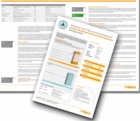How better use of your BMS can make you a CRC winner

The CRC Energy Efficiency Scheme will inevitably produce both winners and losers. Which group a participant falls into could be decided by the effectiveness of its BEMS, says Chris Monson.
The CRC Energy Efficiency Scheme is a mandatory emissions trading scheme aimed at large organisations that are non-intensive energy users, a group that is responsible for some 10% of UK carbon emissions. Those whose half-hourly metered power consumption was at least 6 GWh in 2008 — equivalent to an electricity bill of roughly £500 000 — will be required to become full participants in the scheme. An estimated 5000 public and private sector bodies will qualify and will have to buy ‘allowances’ equivalent to their annual CO2 emissions.
During the first year of the scheme (2010/11) participants will only be required to record their carbon emissions. From April 2011 they will have to start purchasing annual allowances for the forthcoming year, initially at £12/t CO2, but rising to a possible £40 to £50/t after 2013 — when there will be a cap on the number available.
All revenue raised from the sale of allowances will be returned each year in the form of recycling payments. The share each participant receives will be in proportion to its 2010/11 emissions, adjusted for performance. It will be determined by its ranking in a league table that compares participants’ success at reducing their emissions. Those towards the top of the table will receive a bonus payment and the higher they are placed the more they will get; conversely, those at the bottom end will incur a financial penalty and the lower their position the greater this will be. Thus, organisations that perform better than average not only have to buy fewer allowances but also get a larger share of the recycling pot.
The maximum bonus/penalty rate will start at ±10% of a participant’s expenditure on allowances and will be increased annually until it reaches ±50% in 2015. The cost of the allowances themselves will also escalate, allowances themselves, so that the financial impact of the CRC scheme will increase dramatically.
It is a reasonable assumption that most participants will have installed building energy management systems to regulate and monitor their heating, ventilation and air conditioning — and possibly their lighting. Such systems will consequently be controlling 40 to 70% of their total energy use. However, although BEMSs undoubtedly have the capability to run a building’s services without wasting energy, many are likely to be falling short of this ideal.
Fortunately it can be easy to improve the performance of a system performance. BEMS surveys conducted by Trend Control Systems have shown that energy savings of up to 25% are possible through corrective actions involving little or no cost. Often it is a matter of just resetting temperature setpoints and building occupation times, disabling manual over-rides or relocating or recalibrating sensors. Refining control strategies can also make a big difference; for example room air-conditioning units that are set to run continuously could instead be controlled using presence detector signals.

Organisations covered by the CRC should strongly consider calling in a controls specialist to review the operation of their BEMS. They are very likely to find that the cost of the assessment will be more than paid for by the immediate savings that result. The review should also examine the system’s potential for development to make even greater energy savings. This will generally entail matching control of the building services more closely with demand. For example, particularly large savings can often be made by fitting variable-speed drives on pump and fan motors or by greater zoning of a building to allow more areas to be independently controlled.
Though such developments will invariably require additional hardware to be installed and/or new control strategies to be implemented, the investment involved is likely to be more than justified by the resultant savings and payback period. For those affected by the CRC scheme the business case will be particularly compelling.
Given that CRC bonus payments will be based on improvements in emission levels (compared with a rolling average for previous years since 2010/11), it might seem worthwhile to delay any investment until the higher bonus rates kick in during 2014 and 2015. However, this argument ignores the fact that cumulative energy cost savings — unrelated to CRC — will obviously be greater if action is taken early. In fact, over the first five year phase of the scheme they will probably considerably outweigh the value of potentially higher bonus payouts.
Even without the introduction of the CRC, most of the participants would undoubtedly have benefited from a thorough review of their BEMS. The new scheme provides them with an added incentive. As well as cutting the cost of running their building services, the measures resulting from a review will reduce their CRC liability, with many of them possibly getting more money back than they spend on allowances.
Chris Monson is with Trend Control Systems Ltd







